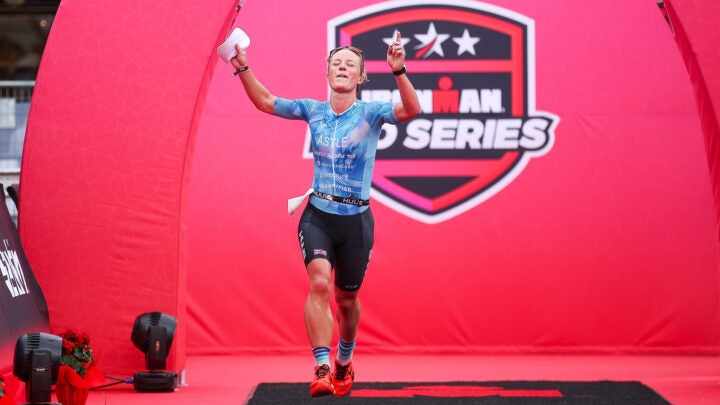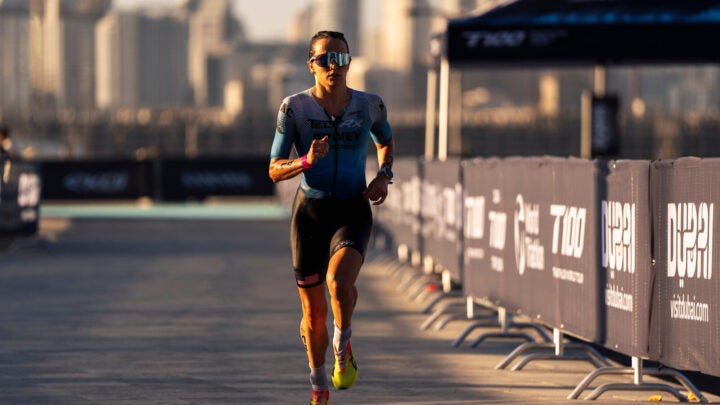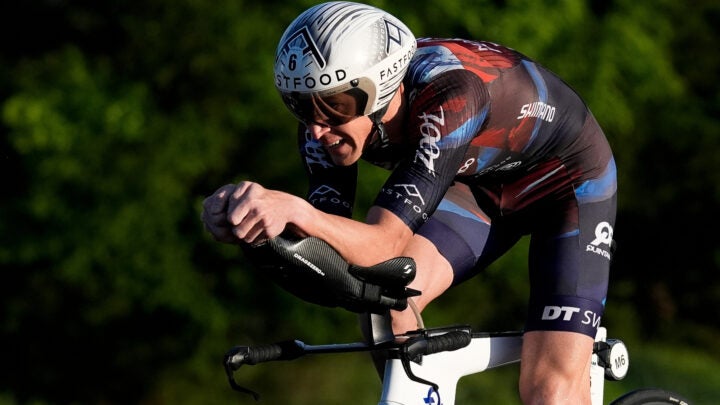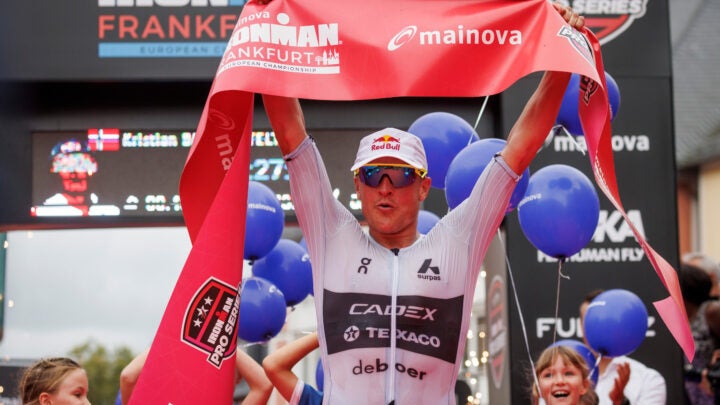New perk! Get after it with local recommendations just for you. Discover nearby events, routes out your door, and hidden gems when you sign up for the Local Running Drop.
Can you make a living from endorsements in professional triathlon? Is sharp social media worth more than a podium performance? Will athletes peddle any product that pays? Should you have an agent? And are negotiations really just a game of bluff and counter bluff?
There are many questions on the science (or art) of sponsorship in swim, bike, run, and the answer largely depends on whom you talk to. Brands come at it from one angle, agents from another, and athletes, particularly those who represent themselves, have an entirely alternative view.
That said, they all agree that those at the very top of the sport – particularly in long-distance racing, where Ironman, and increasingly the T100 Tour, provide a flourishing shop window for sponsors – make a tidy sum.
“For an Ironman world champion, it’s relatively easy to get really good endemic and what we refer to as semi-endemic partnerships,” says Adam Acworth, the founder of Santara Group that represents Kristian Blummenfelt, Gustav Iden, and Rudy Von Berg among its roster of big name professionals in the sport. “The value for an athlete like this is huge, making seven figures on sponsorship before prize money and bonuses each year. However, the drop off is significant.
“A top triathlete who is, say, [ranked] five-to-ten [in the world] is still making a very good living, around $350k-$500k annually, but once you get out of the top 10, things become harder. They will be full-time professionals, should have some solid endemic partners, and can earn a little from appearance fees and prize money, but with overheads – training camps, traveling to races, coaching, etc., it means they won’t finish the year with a huge profit, unless they have one or two outstanding results at big races.”
Razor-thin margins as a pro triathlete
This is a “middle world” that British professional Ruth Astle knows well. The 35-year-old’s career-best result was a fifth-place finish at the Ironman World Championship in St George in 2022. But since then, despite winning Ironman Israel and finishing in the prize money at the Hawaii Ironman World Championships twice, it has largely been a frustrating tale of injury and thin financial margins.
“I’ve a lovely budget spreadsheet that shows my sponsorship income,” Astle, who has built a reputation for transparency and releases an annual earnings video on YouTube, says. “And I think, even without paying rent or a mortgage, I need about $50k to cover outgoings.”
Life as a pro isn’t cheap and while race results aren’t the only yardstick brands use to measure return on investment, sport is fickle. A barren spell makes negotiations trickier. “What I see in the sports world would not pass in any other industry,” Astle, who worked in the banking sector before turning professional, continues. “I might email the chief executive or head of marketing and they’ll respond saying it’s great to hear from me and provide the email address of the person in the company to talk to. But then you get nothing. No response. Yet you know the email address is correct because someone senior has given it to you. That’s just rude.”
Astle confirms that several sponsors have tried to downgrade their offering to product-only deals, but while she understands the business rationale – “I’ve had two s*** years” – she says it’s the delay in finalizing the contract that is the most frustrating aspect.

“I was very proactive in trying to reconfirm and sort contracts in October, but then they’re not signed until mid-January,” she adds. “In the background there might be conversations with agents, and if they get a better athlete, I’ve no issue, but don’t string me along saying we’ll continue on similar terms and then suddenly send a contract with a lot less cash.”
Astle also thinks that sports agents, particularly those with multiple clients, add to the predicament. “My sense is that agents monopolize various brands for all their athletes and block it for other people,” she says. “And, depending on who the agent is, [the brands] are not going to want to piss them off because they know they have good athletes. It makes complete sense.”
If you can’t beat ‘em, why not join ‘em then, and get an agent of your own? “I could have taken an agent right after St. George [in 2022] and potentially had better deals, but I’d be giving away a percentage of the very small cash I make,” Astle continues. “Plus, I didn’t meet anyone I trusted. No one came to me with a [new] offer, and I don’t just want to hand over a cut of deals I’ve already got.
“The positive of not having an agent is that I have the relationship with brands, but on the other hand, it can make it hard knowing where to pitch myself. At the end of last year, I messaged loads of athletes to ask what deal they were on and if they were happy sharing. A lot of them were.”
The short-course landscape, versus long-course racing
Jordan Blanco, who is based in California and manages Olympic silver medallist Taylor Spivey – who is also a T100 Tour “Hot Shot” athlete in 2025 – says she spends a lot of her time convincing athletes they don’t need an agent. “Brands want direct relationships with athletes, and I think having a manager or agent is only important when you have some bigger brand deals with content requirements that you need an extra pair of hands to execute.”

Spivey, 33, has been one of the most consistent short-course triathletes in the world in the past decade, thriving on the World Triathlon Championship Series and in the fast-paced Supertri series, as well as winning mixed team relay silver with the USA in Paris. But having competed in the final three T100 races last season and signed a contract with the Professional Triathletes Organization for the 2025 series, Blanco says more sponsorship opportunities have opened.
“To say ‘sky rocketed’ is a stretch, but interest has increased dramatically,” Blanco confirms, explaining that a long-course racer offers more appeal to the North American market, especially one that hails from Redondo Beach, California, who fans can root for.
“Short-course racing is a harder sell,” Blanco continues “There’s just not as much visibility. The bikes are in the middle of a pack, you’re not getting side-on shots, they’re racing in national team kits, and nutrition is not [as big a factor] within the race.”
If the T100 effect is working well for Spivey, then it has demonstrably jumpstarted the fortunes of British triathlete India Lee. Lee ended 2023 at number 15 in the PTO rankings, was one of just 20 women to be offered a contract for the seven-race series, and then won the opening race of last year’s series in Miami in March.
“That allowed me to plan my year, and not be dependent purely on prize money, then the win changed things for sure,” Lee says. “But mainly because I got more social media followers, and that’s a metric brands care about more than pure results. Although budgets had been assigned, so current contracts didn’t change, my manager had an easier time negotiating for this year.”
Lee’s social media following has now jumped to almost 20,000 followers on Instagram, but the easygoing Brit has also become a staple of light-hearted T100 YouTube content.
Blanco credits the greater reach and storytelling of T100 Tour, the Ironman Pro Series, and even World Triathlon’s new Dare to Dream docuseries as the biggest boon for athletes’ earning potential.
“We’re at a sweet spot now, with increased media exposure and brands looking to align with certain series,” Blanco explains. “The broadcast potential definitely has brands not wanting to miss out, and knowing Taylor is part of the T100 this year, and knowing the schedule, is also helpful. Her biggest [Instagram] reel last year had 11 million views after it was amplified through T100.”
View this post on Instagram
Social media can be hard work made to look easy though, and you only need to scan a few accounts to see how it suits some athletes more than others. “Taylor is someone who is excellent on social media and has done a nice job creating her content over years,” Blanco says. “It’s all produced by herself, she takes pride in that, and it resonates. But the most successful [still] typically garner most sponsorship dollars. [Reigning T100 world champion Taylor] Knibb is a great example. It’s not that she can’t produce social media, but she chooses to invest in performance and doesn’t need to spend time on social media.”
What about pro bike sponsorships and other gear?
Jay Prashun, head of marketing at triathlon-dedicated bike brand Quintana Roo, explains how the social media of stars like Matt Hanson, who finished joint fourth in last year’s Ironman Pro Series, is important for Quintana Roo’s direct-to-consumer approach.
“We’re not as large as some other brands, but the key has been to build relationships with athletes who can both produce results and be on the journey from a product development standpoint,” he explains. “Matt and Jodie Robertson [second place in Ironman Canada last year] were instrumental in the development of the V-PRi and because the media landscape has changed in the past seven-to-eight years, it’s important to have athletes that speak to their experience with our brand on social media – triathletes go there to find information about the athlete and the products they use.”

While triathlon bike sponsorships might be becoming harder to secure for pros, Prashun says it remains central to Quintana Roo’s marketing strategy. “You hear some brands are pulling back on support, but because we only play in the triathlon space and don’t have a pro tour cycling team or mountain bike racer, triathletes are our bread and butter, it’s super important to us to support athletes to the best degree we can.”
For the top professionals like Hanson, this means equipment alongside a cash stipend and a performance-related bonus package, and for lower-ranked pros, Quintana Roo says it’ll be launching a factory racing team that Prashun hopes will also prove appealing.
“These are developing and rookie athletes who probably have to go to their local bike shop to buy a bike at a [discounted] pro rate,” he says. “We’re giving them pro pricing on a QR, and creating a performance bonus schedule that is the same as Matt Hanson. It pays all the way down to PTO bronze level events [the lowest ranking tier that have a pro prize purse of $10k], so they truly have an opportunity to earn without having to get a top 10 in Kona or Nice.”
Bike sponsorship is a category where professionals need to swallow their pride and understand their value. First, given it’s the piece of equipment that they’ll be using more than any other in training and racing, it needs to work for them. We saw last year that 2022 Ironman world champion Chelsea Sodaro mutually ended her deal with Canyon and switched to an unsponsored setup with a Pinarello Bolide TR. A third place in the Ironman World Championship in Nice last year helped ratify that decision.
View this post on Instagram
Secondly, while cash deals can be hard to come by for certain tiers of pros, athletes can benefit from the resale value of product-only arrangements. “Most bike brands don’t ask for a return frameset,” Blanco says. “And if you are given two or three a year, and can sell them when you’re finished with them, it is a form of income.”
Comparison can be the thief of joy here because not everything is always as it appears either. “It can be hard to know who is really sponsored,” Blanco continues. “Being on a bike and having a logo on a kit could mean anything from a free frameset to $50-100k.”
Ryan Bowd, a sports agent who represents U.S. triathlete and Ironman Lake Placid winner Danielle Lewis and last year’s Challenge Roth runner-up Tom Bishop (GBR), says bike brands’ offers should be taken at face value: “The bike industry has historically been generous to triathletes and is made up of people who have been in, and love, the sport,” he says. “When times are good, they’ll support as many athletes as they can. When times are tough, which it definitely has been for the industry in the last few years, it’s more challenging.”
It’s a view shared by Acworth, although he does see other sponsorship areas prospering. “The bike industry is in a very different position now financially than it was just after COVID, when they had so much cash, they almost didn’t know what to do with it. Literally, a global head of sponsorship said that to me,” he says. “But the nutrition sector, for example, is booming, with many great brands doing really well, i.e., The Feed, Maurten, N2, Raw, Z2 MNSTY, PF&H, 226ers. It means there is a lot of competition in the market. A few years ago a product, bonuses, and maybe a small amount of cash would be a good deal, now it is one of the more lucrative sectors.”
Best practices for pro sponsorships, from the experts
It leans into the thorny topic of whether professionals give endorsements to products they wouldn’t typically use, purely because of the cash. Astle believes that particularly in “wellness” and “general health-related” product categories, it would be naive to think athletes aren’t just spinning a marketing line. “People have got to make money from somewhere, and if they offer you cash, take it,” she says. “The lifespan of an athlete is short, and if you’re saying ‘I take this sometimes to stay healthy’ and you’re not trying to market it as the best thing ever, then fine. That said, I wouldn’t want it to be anything I didn’t want to use because it’d be a faff pretending, and I’d probably get caught out! I wouldn’t want that stress.”

Acworth doesn’t rule out a little massaging of the truth either: “I did notice one [instance] on social media last year, which was 100% money over product, as we all know this particular product doesn’t work. But I think it’s rare to see top athletes do this, as they don’t need to, and it’s not good for their brand. I believe some more mid-level athletes are, as they need to put food on the table and a roof over their heads, which is totally fair – none of [our athletes do that], I may add.”
Again, it depends on the product category. T100 star Kyle Smith is one of several athletes I’ve interviewed in the past who have purchased their own running shoes because they don’t want to compromise on performance. “I tested every single running shoe on the market and the Nikes worked super well for me, so I abandoned a contract to buy Nikes from the Nike website,” Smith says.
As Astle hinted, Blanco says the other issue with endorsing a product you’re not keen on is that your social media following will quickly call it out. “Taylor [Spivey] and Jackie [Hering] both want to test and try products before feeling good about representing them,” she adds. “If you’re continually swapping and changing and chasing dollars, it can have a negative impact on your reputation.”
Bowd agrees. “When it comes to performance in endemic brands, if it’s a bad brand and you don’t believe in the quality of the product and efficacy, it is more damaging to the performance and psychology of the athlete than it would be by not having a sponsor. Quite often it’s not even a bad product, it’s just not right for that athlete.”
With sponsorships made up of a mixture of salary, product, performance bonuses through both podiums and rankings, as well as travel stipends to events sponsors would like to see athletes attend (Spivey has one Japanese sponsor who insists she races WTCS Yokohama, for instance), what is the best way to get support?
“Be realistic,” Bowd says. “It’s really easy to see top pros, and think you should be there too. The reality is it is hard earned. Seek out brands in the sport that you want to use, and it might be starting on a product-only basis.
“Being young doesn’t mean you can’t get support, but look in the right places: Where is the audience you can have an impact with? What are the relationships that can help you, and if you lean into something they will stay with you for a long time. Target the right level and you can end up with more support than higher performing athletes.”
Acworth’s view is to “focus on being the best athlete you can be, that is going to get you noticed, and if you have a good agent, the deals will come over time.” He also urges athletes to harness the power of social media.” It’s huge. Learn how to use social media to grow a following. If you are young, up and coming, only sign short, one-year deals while you are growing.
“We always use this strategy with our young athletes. Take Kristian as an example. We knew he was going to be a superstar, so we only signed him one-year deals for a few years, really until he became world and Olympic champion.
“If you sign longer-term partnerships, in the moment it could look good, but if you start performing and winning big races, it can start to look like a bad deal very quickly, even with bonuses and roll-overs. Lastly, understand at the start of your career and working with brands, you need to over deliver.
“A mentor of mine, who managed some of the biggest athletes of all time in tennis, golf, and motorsport, said to me: ‘I use to tell my athletes, when we sign a sponsorship deal for you, that is when the work really starts, we want to over service the brand so when it comes to re-signing with them, they’ll want to pay you double!’”
